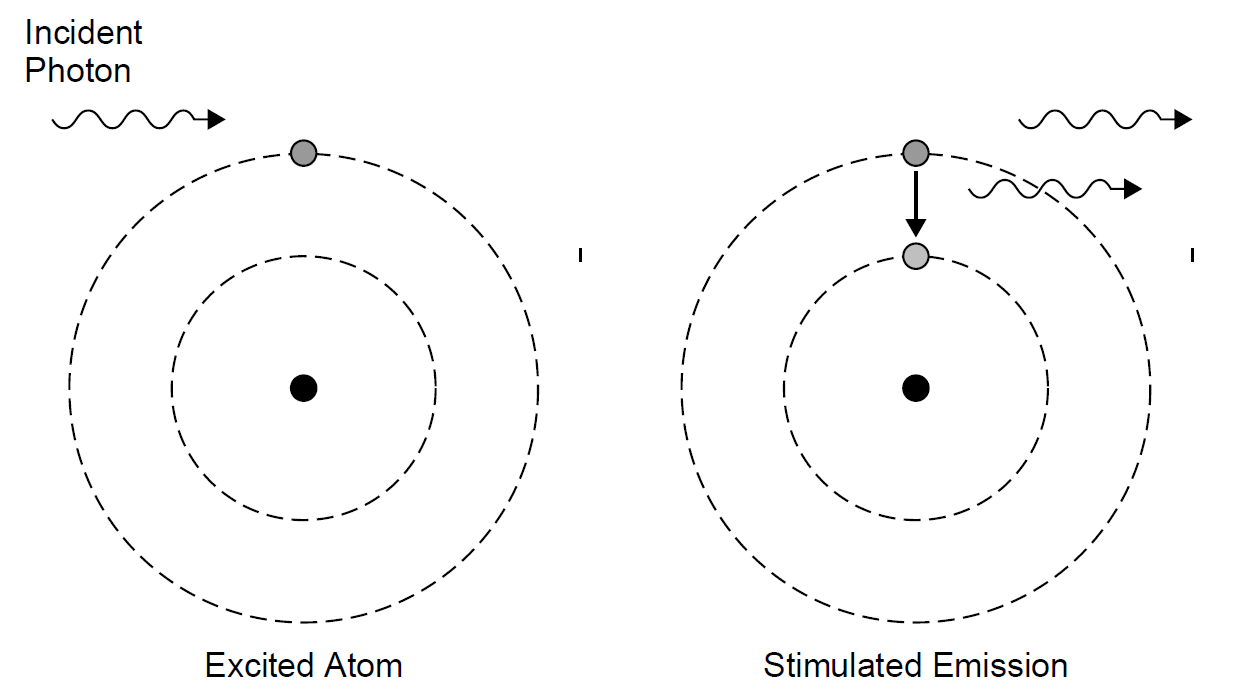
STIMULATED EMISSION
 المؤلف:
Mark Csele
المؤلف:
Mark Csele
 المصدر:
FUNDAMENTALS OF LIGHT SOURCES AND LASERS
المصدر:
FUNDAMENTALS OF LIGHT SOURCES AND LASERS
 الجزء والصفحة:
p90
الجزء والصفحة:
p90
 10-3-2016
10-3-2016
 2386
2386
STIMULATED EMISSION
If a photon of light at an energy of, say, E is fired into a cell containing atoms at ground state, it is possible that it will be absorbed and, in the process, pump the atom to a higher-energy state. The energy of the incident photon must be at least equal to that of the upward transition. This, of course, is absorption. If the atom is already in a high energy state, though (the upper-energy level we refer to continually), and a photon of the correct wavelength comes along (the wavelength corresponding to a transition from the upper state to a lower state in the atom), it can stimulate the excited atom to emit a photon of exactly the same wavelength and phase as the incident photon, leaving two photons exiting this process going in exactly the same direction. The fact that these two photons are identical makes the emitted radiation coherent and monochromatic, two key properties of laser light. The fact that they are emitted in the same direction will play a role along with a well-aligned cavity in making the light collimated, the third key property of laser light. In essence, the original photon is amplified by this process, which is called stimulated emission. The word laser is an acronym for “light amplification by stimulated emission of radiation”; stimulated emission is the key process here. The process is diagrammed in Figure 1.1.
Of course, the atom that emits the photon loses its energy in the process and must be pumped to an excited state again or it will reabsorb another photon. This is why population inversion is (generally speaking) required: If inversion is not maintained, atoms will absorb rather that emit photons of light. This is a not trivial outcome. When the population of atoms at the lower state exceeds that of the upper state, emitted photons of laser light are actually absorbed and laser action is not possible. This effect can actually be demonstrated by passing light from a gas laser (e.g., a He Ne laser) through a cell containing the same but unexcited gas as the laser. In the process of passing through the cell, the power of the laser will actually be measurably reduced.
At this point, the analysis of the situation becomes statistical. Statistically speaking, we require a higher rate of stimulated emission than absorption. Each of these rates can be computed. Another consideration, though, is spontaneous emission. This creates an alternative, unwanted, pathway, allowing atoms in the upper energy state to lose their energy by emitting a photon of light spontaneously. In the case of

Figure 1.1. Stimulated emission from an excited atom.
the helium–neon laser, this spontaneous emission shows up as the pink glow from the tube (which is, of course, composed of discrete lines like any other low-pressure gas discharge). Spontaneous emission robs the upper level of atoms that would otherwise be available for stimulated emission. Finally, we must consider attenuation of emitted laser light by the gain medium as well as the mechanisms of the laser itself (windows, mirrors, etc.). Generally, all mechanisms causing a reduction in laser gain (absorption in the lasing medium and optics, etc.) are referred to as losses, which we consider later.
 الاكثر قراءة في مواضيع عامة في الليزر
الاكثر قراءة في مواضيع عامة في الليزر
 اخر الاخبار
اخر الاخبار
اخبار العتبة العباسية المقدسة


